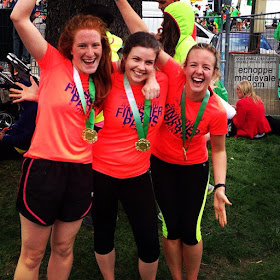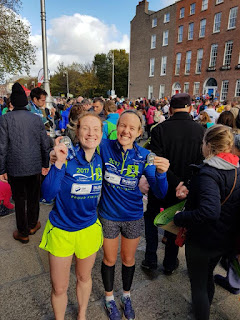By Jennifer McKenna
Paris Marathon 2015 – 4h46
Loch Ness Marathon 2016 – 4h09
Dublin Marathon 2017 – 3h38
What is my relationship with marathon running?
When I signed up for my first marathon in October 2014 I had no intention of ever doing another. Exercise-wise I tended to jog (slowly!) 3 times a week, and go to the gym or a spin class a couple of times a week. I claimed ‘I don’t sweat!’, when I compared myself with others, and didn’t think anything of it.
The aims of my first marathon were:
a) Complete it.
b) Enjoy it.
I signed up for it with 2 of my closest friends, and we decided that it was a good goal, plus an excuse for a holiday. I joined a local running club, downloaded a beginners marathon training plan, and off I went. Immediately, I noticed the difference being part of a running club. My first run was 9 miles long, and I would have NEVER done that on my own, especially on a cold, windy, rainy October evening. So to summarise, I followed a standard plan, jogged at no matter what pace, and focused on trying to build up miles slowly. On the day of the marathon itself, I ran it with my two friends, and it was definitely an aerobic pace! We chatted most of the way round, danced at the music stations, took a selfie at mile 17 (where we passed the Eiffel Tower) and finished the race, content and smiling. At the time I felt like that was 100% effort as I had never attempted something like that before.
 |
| Paris Marathon – April 2015 |
Following this first marathon, I decided to enter the world of triathlon. I kept getting a tight ITB which resulted in knee pain, and I felt like such intense runnning distances wasn’t healthy for my body. So fast-forward one year of very basic triathlon training (and joining a triathlon club), a couple of sprint triathlons and 1 standard, I attempted marathon 2: Loch Ness. This was a very different experience as it was much more rural, less atmosphere, and more hills. I was way fitter than last year, but struggled more mentally. I put too much pressure on myself to go sub 4 hours, and was constantly glancing at my watch to check I was running under 9min/miles. At around mile 19 I suddenly felt completely overwhelmed and fatigued, and started to have what I would now describe as a panic attack. I had a lot of self doubt and started comparing myself to other runners that were going faster and didn’t look to be struggling. This was a terrible thought process, and I ended up walking/ very slow jogging the last 5 miles, which brought my final time to 4h09, when I knew physically I should have been able to run sub 4h. I also didn’t feel good about myself, which isn’t why I do sport so I knew something had to change.
 |
| Looking on the bright side after a less successful race- running with my pal, plus another great T-shirt! |
What enabled me to run sub 4 hours?
1. I got a coach.
This self-doubt and negative mentality was NOT conducive to racing well. Should I go to a spin class today? But my friends are running and I like to be sociable so maybe I should do that? Should I take a day off because work was manic and I’m exhausted? I am terrible at making decisions, and don’t know when to say no. I wanted reassurance that I was doing the right thing, and guidance on my training plan. I am also a serial socialite, and if there were races posted on my clubs Facebook group, I was signing up for most of them, which was giving me a very busy lifestyle, and a very shameful looking bank balance! I wanted someone as a sounding board, to talk through my plans.
This was actually the fundamental change to my training, because all other subsequent changes listed below, were due to discussions and guidance from my coach, Karl Zeiner.
Now, coaches are expensive, so I decided to give up my monthly gym membership, and rein in the sociable coffees to allow me to commit to a coach. I was reticent at first; firstly because I do like to do sociable training so I was worried I would end up doing all of my training alone, and secondly because the coaching was over an app! That blew my mind, as I still pictured a traditional coach meeting up with me and screaming at me as I ran full pelt. I didn’t know how it would work.
After an initial meeting over coffee, where I voiced my main concerns over another marathon (mental barriers on race day plus self doubt), and Karl started forming a plan…
2. I increased intensity, not volume of training.
I am a teacher, and have a social life. I have massively improved fitness since I first started out in 2014 but let me be clear- I like to eat cake, and drink wine, and go out for dinner with friends as well as fit in training. I found that my plan actually gave me MORE free time, through better planned sessions and varied intensity. Karl tended to have me doing a couple of tempo sessions on flatter ground a week, which I was able to do from my house as an out and back. Knowing that he was going to check my sessions made me up the intensity to match what he recommended, and guess what- I DO sweat as much as the next person! I suppose I just wasn’t used to pushing myself that hard, although I thought I did at the time.Park Run was another session that helped me increase my pace- highly recommend finding one near you if you haven’t already!
As I still wanted to maintain triathlon training, I continued to swim 2-3 times a week (with my club so was still social), and cycle once a week (1-1.5h). I love a hilly run with my pals in the Pentland Hills too (chatty pace), so he also made time for that in my training plan, it was usually used as my longer run, when building up to 2-2.5 hour runs. This brings me to another new technique; running to time rather than distance. The first 2 marathons I would set off thinking ‘I have to do 18 miles today because it is on my plan’ which could be overwhelming, where as this time it was a 1 hour tempo session at a specific heart rate, or a 3 hour aerobic session at a lower heart rate. This immediately changed my mindset when approaching the run sessions.
3. I ran for 30 minutes, then walked for 1 minute.
The panic attack I experienced during Loch Ness was not an isolated experience. I have had them during half marathon races too, and longer training runs. As I thought it was due to being daunted by the distance, Karl suggested that I broke these longer runs into smaller sections, and walked for a minute every 30 minutes. I don’t like glancing down at my watch as it makes time go slower, so I programmed my watch to beep every 3 minutes, then after 1 minute x 6 for example. During the 1 minute I made sure I had an energy gel (High 5 orange is my fave), and some water. This made a MASSIVE difference, and I found time flying by. I wasn’t glancing at my watch looking at pace, I was occasionally checking my heart rate, then just waiting for the beep as I enjoyed my run.
4. I practised, and stuck to, a nutrition plan.
On my first long run (18 miles) I noticed I slowed right down at the end, and also had another panic attack. I also took all day and evening to recover from this run. I reflected that I stopped having gels after 2 hours as I was getting sick of the sugar, and also thought ‘It’s not that far until I get home’. I reckon that was linked to the additional fatigue and panic I felt. After this, I made sure I stuck to having a gel, even if I didn’t fancy one. To try and vary my intake, I also bought some Bloks which were quite good to stop me getting bored of the gels. This still took some effort, as I don’t like how much sugar I am taking in, but I suppose it is only for long runs and race day, so considering my average day is pretty healthy, I am trying to change my mindset on this as it really did make a difference!
5. I ran different intensities by looking at heart rate, rather than pacing.
Karl set my heart rate zones, and I tried to stick to them. this encouraged me to vary the intensity of my training, and like I mentioned previously, not become so fixated on maintaining a specific pace.
6. I took rest days, and tapered!
Without a coach I get TOO excited. Signing up for races left right and centre (then sometimes realising that a 10k is about 4 hours drive away and not going anyway). I also don’t pay as much attention to rest days. This year I made sure I made time (and money) for hot yoga, foam rolling, and sports massage. I am delighted to say that this is the first year I felt no injuries, and was my fastest marathon! So I really believe that it helped to recognise the benefits of rest and recovery.
The plan on race day.
Do what I PRACTICED. Run for 30, walk for 1. Take gels and bloks, only the ones I tried in training. Only look at heart rate, don’t worry about timing or pace to keep me calm. Enjoy it, stay in the moment, and do my best. It worked! I stayed hydrated, had energy, and it flew by. I loved it. I even managed a sprint finish for the last 800m. Absolutely delighted. Will I enter another? Probably. Will I aim for sub 3.30? Hmmm maybe. I will continue to train with my wonderful coach Karl, work towards my first Ironman in 2018, and see what happens… watch this space!
 |
| Dublin 2017- Running separately now, but crossed the finish within 2 minutes of each other! |
Finally, thank you.
Thank you to Karl, for your patience and belief in what I could achieve. To Nadine for running so many of these races with me, acting as a friend, running partner and life coach all in one! And Phil, my partner in crime, without your support throughout the year as well as on race day itself this journey would be a lot less fun.




